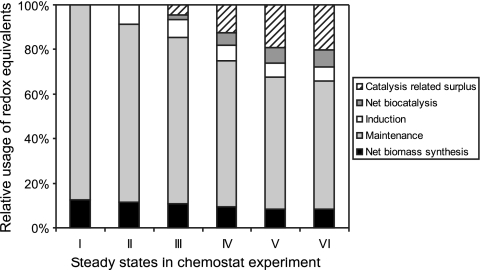FIG. 6.
Relative usage of the redox equivalents [NAD(P)H] produced by glucose catabolism during the continuous cultivation shown in Fig. 4. In the absence of induction and biotransformation in steady-state I, NAD(P)H is consumed for net biomass synthesis and maintenance requirements (e.g., transport processes and macromolecule turnover), which were assumed to remain constant during induction and biotransformation. Under biotransformation conditions, the total amount of NAD(P)H formed is further subdivided into redox equivalents consumed for styAB expression (induction, constant requirements were assumed), NADH consumed for net biocatalysis with a stoichiometry of 1 mol per mol styrene oxide produced, and surplus redox equivalents consumed during biocatalysis.

